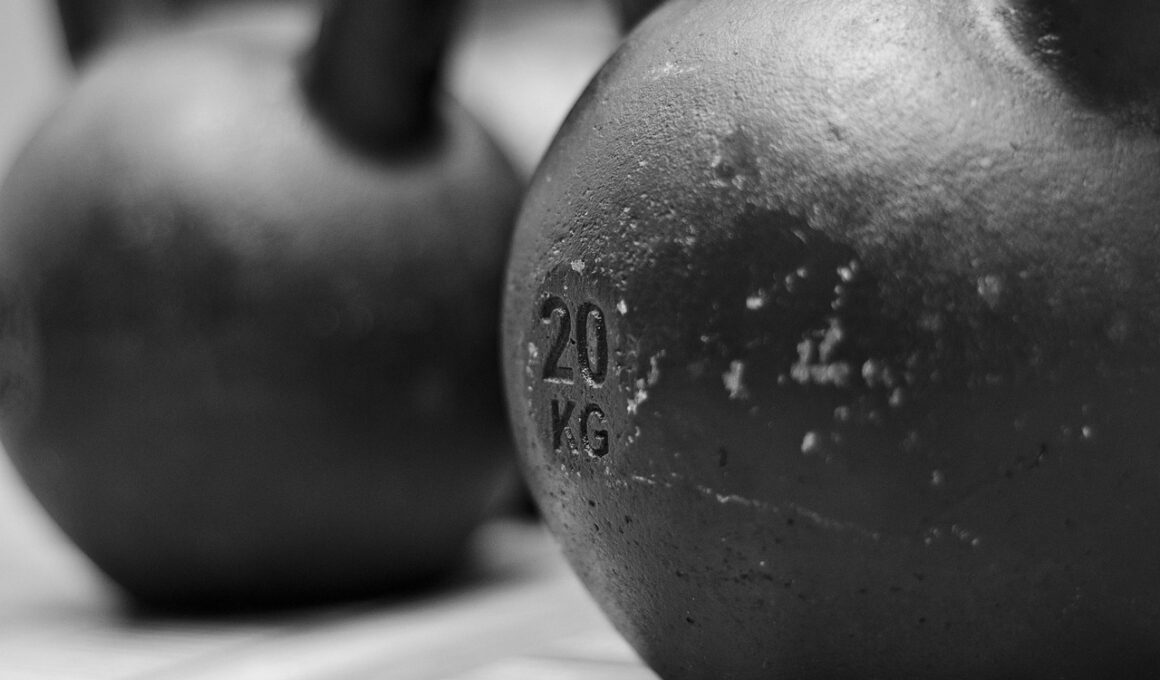Kettlebell Thruster: Combining Squat and Press for Total Body Power
The kettlebell thruster is an advanced exercise that effectively combines a squat and an overhead press, making it a powerful multifunctional movement. To perform the kettlebell thruster correctly, begin by holding a kettlebell at the chest position with both hands. Your elbows should tuck close to your sides, and your feet should be shoulder-width apart. Initiate the movement by bending at the knees to lower into a squat while keeping your torso upright and back straight. It’s essential to engage your core throughout the squat to maintain stability and balance. As you hit the lowest point of the squat, reverse the motion explosively by pushing through your heels, driving upward. As you stand back up, transition into the pressing phase: extend your arms overhead while still holding the kettlebell firmly. This compound movement not only improves strength but also enhances endurance and cardiovascular fitness. Performing kettlebell thrusters can be beneficial for building overall body power, making it a favored exercise among athletes and fitness enthusiasts alike.
Benefits of the Kettlebell Thruster
The kettlebell thruster offers numerous benefits to those who incorporate it into their training regimens. Firstly, it’s an excellent full-body workout, targeting multiple muscle groups such as the quadriceps, hamstrings, shoulders, and core, allowing for effective muscle recruitment. The combination of squat and press enhances coordination and balance, which are essential for numerous athletic endeavors. Additionally, this exercise can elevate your heart rate, making it beneficial for cardiovascular fitness. By performing the kettlebell thruster, individuals can experience improved metabolic response, leading to increased calorie burn during workouts. Another advantage is its adaptability: whether you’re a beginner or an advanced lifter, by adjusting the weight of the kettlebell, you can tailor the intensity to suit your fitness level. Furthermore, regular practice of kettlebell thrusters can also lead to functional strength improvements, enhancing your ability to perform everyday tasks with ease. Be sure to incorporate this dynamic exercise into your routine for a comprehensive and vigorous workout experience that effectively grooms both strength and endurance.
To execute the kettlebell thruster with proper technique, start with proper warm-ups. Warming up prepares your muscles for the workout session, reducing the risk of injury. Begin with dynamic stretches focusing on the legs, shoulders, and hips. Another important aspect is to maintain a correct posture during the thruster. Ensure your back remains straight throughout the movement to avoid undue strain, and actively engage your core muscles. Pay attention to the foot placement: your feet should be rooted firmly on the ground, providing stability as you perform the overhead motion. Transitioning from the squat to the press phase requires seamless coordination; focus on driving your body upward while simultaneously extending your arms to lift the kettlebell. It is also crucial to breathe appropriately: inhale during the squat and exhale when pushing the kettlebell overhead. Incorporating kettlebell thrusters into your workout routine regularly can lead to improved joint mobility and overall fitness gains. As with any exercise, starting with lighter weights and gradually increasing them as strength improves is advisable, ensuring that form and safety take precedence.
Common Mistakes to Avoid
When performing kettlebell thrusters, there are common mistakes that exercisers should be mindful of to prevent injury and maximize effectiveness. One frequent error is allowing the knees to extend beyond the toes during the squat phase; this strains the knees and can lead to injury. Another mistake involves arching the back or leaning too far forward; eccentrically lowering into the squat emphasizes form, and maintaining an upright torso during the lift is crucial. Initiating the press too early or not fully completing the squat can lead to improper execution, so focus on achieving full depth before transitioning into the press. Additionally, neglecting to engage the core can result in instability, affecting your balance. Instead, actively brace your core muscles throughout the movement. Lastly, using a kettlebell that is too heavy can impede form; it’s better to practice with a manageable weight until proficient. Learning to identify these mistakes and focusing on mastering proper form provides benefits and helps enhance overall performance in the kettlebell thruster exercise.
The kettlebell thruster can be creatively incorporated into various workout formats. For example, it fits well into circuit training, allowing you to alternate between different exercises without rest, enhancing cardiovascular endurance. You may pair the kettlebell thruster with movements such as push-ups or burpees for a full-body workout that emphasizes strength, endurance, and flexibility. Another option is to include it in high-intensity interval training (HIIT) sessions. Perform the kettlebell thruster for a set duration, followed by a brief rest, repeating this cycle to maximize calorie expenditure while building strength. Moreover, consider participating in kettlebell-focused classes or online workout programs for guided instruction. As you progress, you can vary repetitions, sets, and even the kettlebell weight. To get the most out of the kettlebell thruster, integrating it with functional movements ensures that your body adapts efficiently. Alongside maintaining proper nutrition and hydration, regular practice will further improve muscle tone, stability, and athletic performance overall. Therefore, embrace the adaptability of the kettlebell thruster in your training for continued advancements.
Progressions and Variations
As you become proficient with the basic kettlebell thruster, consider exploring various progressions and variations to enhance your training experience. One effective progression is the single-arm kettlebell thruster, which adds an element of instability and engages the core more intensely. This demands greater focus on balance and coordination. Another variation is to add a pause at the bottom of the squat, increasing time under tension and ultimately challenging your strength. Explore incorporating a jerk motion for a more dynamic upper body strength challenge during the lifting phase. You can also experiment with tempo variations by slowing down the descent and speeding up the ascent, which changes the workout intensity as well. Keep in mind to prioritize form and control over speed when attempting challenging variations. Always listen to your body; if an advanced technique feels too complex, revert to the traditional thruster until confidence builds. Adapting your kettlebell training to include these progressions not only maintains engagement but also contributes to continuous strength improvement, ensuring a well-rounded fitness journey.
Lastly, integrating kettlebell thrusters into a comprehensive training plan can greatly enhance overall athleticism and functional strength. You may structure weekly workouts to include specific days focused on kettlebell exercises, ensuring you also balance your fitness regime with other movements. For instance, emphasize mobility or bodyweight movements on alternate days to keep the regimen holistic and varied. Implementing recovery strategies such as stretching or foam rolling on rest days is crucial for muscle recovery. Consider tracking your progress with kettlebell thrusters; logging the weights and repetitions allows you to monitor gains accurately and adjust your program accordingly. Whether your goal is muscle hypertrophy, weight loss, or improving athletic performance, the kettlebell thruster is an incredibly versatile exercise. Consistent practice, combined with strategic variations, can lead to elevated levels of strength, endurance, and overall fitness development. Celebrate small achievements as you progress, and continue to challenge your limits; this not only enhances motivation but also contributes to sustained growth in your workout routines.



